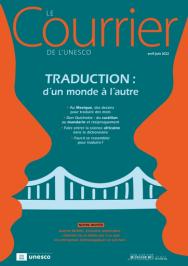Article
Subtitling: Behind the scenes

Roshanak Taghavi
Journalist based in Washington, DC.
“Once you overcome the one-inch-tall barrier of subtitles, you will be introduced to so many more amazing films”, stated South Korean director Bong Joon-Ho at the Golden Globe awards in 2020. His film Parasite became the first non-English language film to win an Oscar for Best Picture, shining a spotlight on the critical role subtitles play in exposing global audiences to the vast world of film.
The international success of the film negated the widespread perception that English speakers are reluctant to read while watching televised content. Indeed, Parasite, which is now streaming on subscription-based platforms worldwide, grossed more than $50 million throughout the United States and Canada upon its cinema debut.
The phenomenal success of subtitled films like Parasite or the South Korean series Squid Game has also brought to light the precarious situation of subtitlers. Do their poor working conditions explain the stark contrast in subtitle quality across shows and films for streaming platforms? This question has prompted debate among the public-at-large.
Unprecedented popularity
In a few years, subscription-based streaming platforms have revolutionized cross-border viewership of foreign-language films and television shows, with localized international content gaining unprecedented popularity among English-language audiences.
In the United States and Canada, viewership of non-English content has increased by 71 per cent since 2019
Roughly 36 per cent of Netflix subscribers are from the United States and Canada, with viewership of non-English content up 71 per cent since 2019, stated Bela Bajaria, Head of Netflix Global TV, at the Television Critics Association’s summer press tour in 2021.
The American giant, which streams content in more than 190 countries, subtitled seven million run-time minutes in 2021, with plans to promote translations and make them even more compelling for subscribers, revealed Greg Peters, Chief Operations and Chief Product Officer at Netflix. The platform is largely considered by Language Service Providers (LSPs) to be a “pioneer” in setting subtitling and dubbing standards.
A vicious circle
Subtitlers, however, do not really profit from this growing popularity of foreign content. “We have this ‘subtitling as an afterthought’ type of model. Money for translation, subtitling, dubbing and access currently comes at the very end of the filmmaking process, when the film or television budget has largely been spent”, says Pablo Romero-Fresco, Honorary Professor of Translation and Filmmaking at University of Roehampton in London.
Expenditure on translation and access typically accounts for 0.01 per cent to 0.1 per cent of a film’s budget
While 50 per cent or more of most films’ revenue is earned from their foreign translated versions, only 0.01 per cent to 0.1 per cent of budget is spent on them. “Is the color correction of a film that is going to be speaking to millions of viewers more important than its translation? It’s a shocking disparity”, Romero-Fresco says.
Subtitlers are generally paid per minute of content rather than per subtitle. According to subtitle translators, who prefer to remain anonymous, this per minute rate has been gradually falling over the past thirty years. Another issue is that there is no standardized process for assignments, contracts or payment, with rates and methods for contracting subtitling services varying vastly by country or region.
“Streaming platforms and content creators themselves are prepared to pay for quality subtitling”, says Stavroula Sokoli, Vice President of the European Association for Studies in Screen Translation. However, these revenues need to reach the translators, which is not always the case. Sometimes streaming platforms give subtitling projects to Language Service Providers (LSPs) who in turn pass them on to smaller vendors. Even if the initial rate paid is high, it decreases as the number of intermediaries increases.
“If you’re only working for vendors or clients who pay very badly, then you have to work all the time because you can’t make ends meet”, says a veteran French subtitler. “And if you work all the time, you can’t have time to meet other [better-paying] clients. It can become a vicious circle.”
The increasing pressure on deadlines and wages, is prompting some longtime subtitle translators to leave the industry. “In the past few years, streamers are expecting a lot more of the linguists: they expect higher quality, they give us a little bit less time, they pay us less than before or the same, even though the cost of living in the world has changed”, says the head of a LSP, speaking on condition of anonymity.
Pragmatic deadlines
Many in the subtitling industry state that subtitling should be integrated in the budget at the start of the filmmaking process, so that a respectable payment rate is included and an appropropriate LSP is selected from the start. That vendor would in turn, have the appropriate funding and time to select a subtitler who is the right fit. Indeed, Bong Joon-Ho’s Parasite was so phenomenally successful because he chose to work with a subtitle translator with particular experience, Darcy Paquet, to ensure the translation’s appropriate context and nuance.
In the near-term, a solution could be for streaming platforms to collaborate with vendors to ensure consistency in subtitler payment and more pragmatic deadlines. This process has started in France, where subtitlers are paid per subtitle rather than per minute for certain films. Streaming platforms are also able to communicate more forcefully with vendors to pay better rates for translation.
“French film producers know that they have to export to countries that speak other languages, so most of the time, they will take that into account from the start”, says Sabine de Andria, a Paris-based translator who has been subtitling for more than twenty years. “If globalization has one positive aspect, it is that it has really made obvious that subtitling and dubbing are essential and they need to be done well”.











